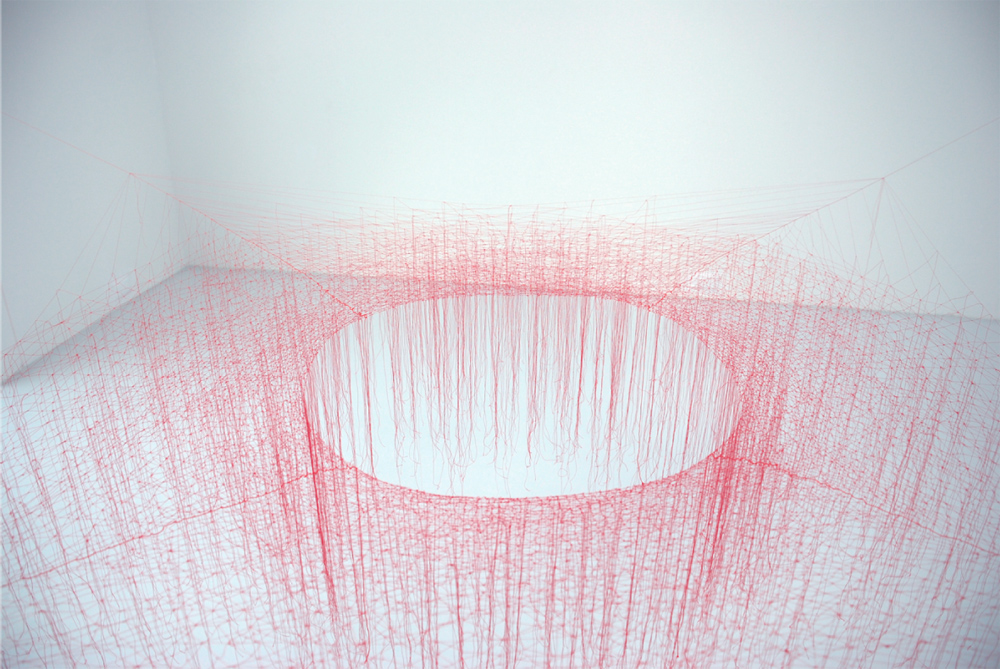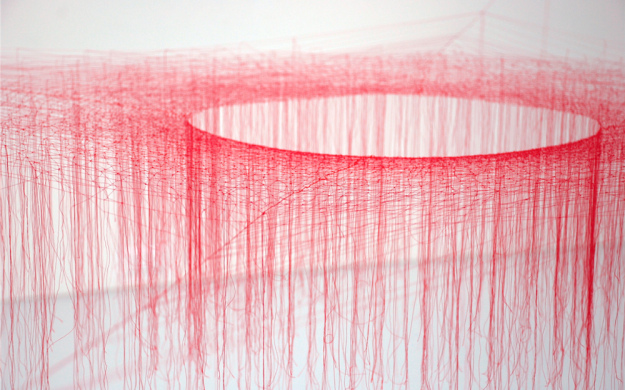Artwork: Akiko Ikeuchi, Knotted Thread, 2011
Red: primary and primal.
The colour of blood; what’s basic to life. It’s a colour associated with passion, love, anger and pain. It’s chromatically intense and draws the eye whether you see it in nature or on the street.
Discovering the work of Japanese artist, Akiko Ikeuchi, what jumped out at me was her use of red thread. Some of her sculptural installations feature white or black thread, but it’s her red thread pieces that drew me in.
Artwork: detail of Akiko Ikeuchi, Knotted Thread, 2011
Using delicate silk thread, Ikeuchi meticulously plans her thread sculptures using 3-D modelling and knots them by hand. The construction is then anchored in space and oriented by geomagnetism: north, south, east and west. These webs have associations with natural phenomenon: whirlpools, hurricanes and galaxies. With the energies of life. Ikeuchi’s creations limn what is seen and unseen; what is tangible and intangible. The viewer engages with the piece through their very movements: the threads vibrate with the air, the changes of humidity, by breath.
Artwork: detail of Akiko Ikeuchi, Knotted Thread, 2011
In Ikeuchi’s words: “I am continuously trying to mediate something invisible, not easily visible in this world, which is mostly fragile.”
As for the colour red, what I found fascinating is the similarity with two other Asian artists I’ve written about in ‘Art Stories’, both featuring red thread in their art.
For Chiharu Shiota, the red thread is a symbol of connection, the “ocean of life”: “It’s like a red ocean you can see from the top. When people look in the space, they immediately can see the universe.” Specifically relating to her installation for the Japanese Pavilion at the Venice Biennale, The Key in the Hand (2015), the threads signify the connection of humans throughout the world by red threads.
This is similar to Beili Lu’s Lure/Wave (2010) installation, except she’s referring to a specific Chinese folk legend, The Red Thread of Fate. It tells of how when children are born, invisible red threads connect them to their soul mates. Over the years, their lives become closer until they eventually find each other, overcoming social and physical divides that might otherwise separate them. This magical cord might stretch and tangle, but will never break. There's a comparable Japanese folk legend, but it extends to all relationships, whether friendships, family, or couples.
I’ve yet to unravel the significance of the red thread for Ikeuchi, but I have a feeling it stems from the life force of the energies she works with to create her exquisite art.


